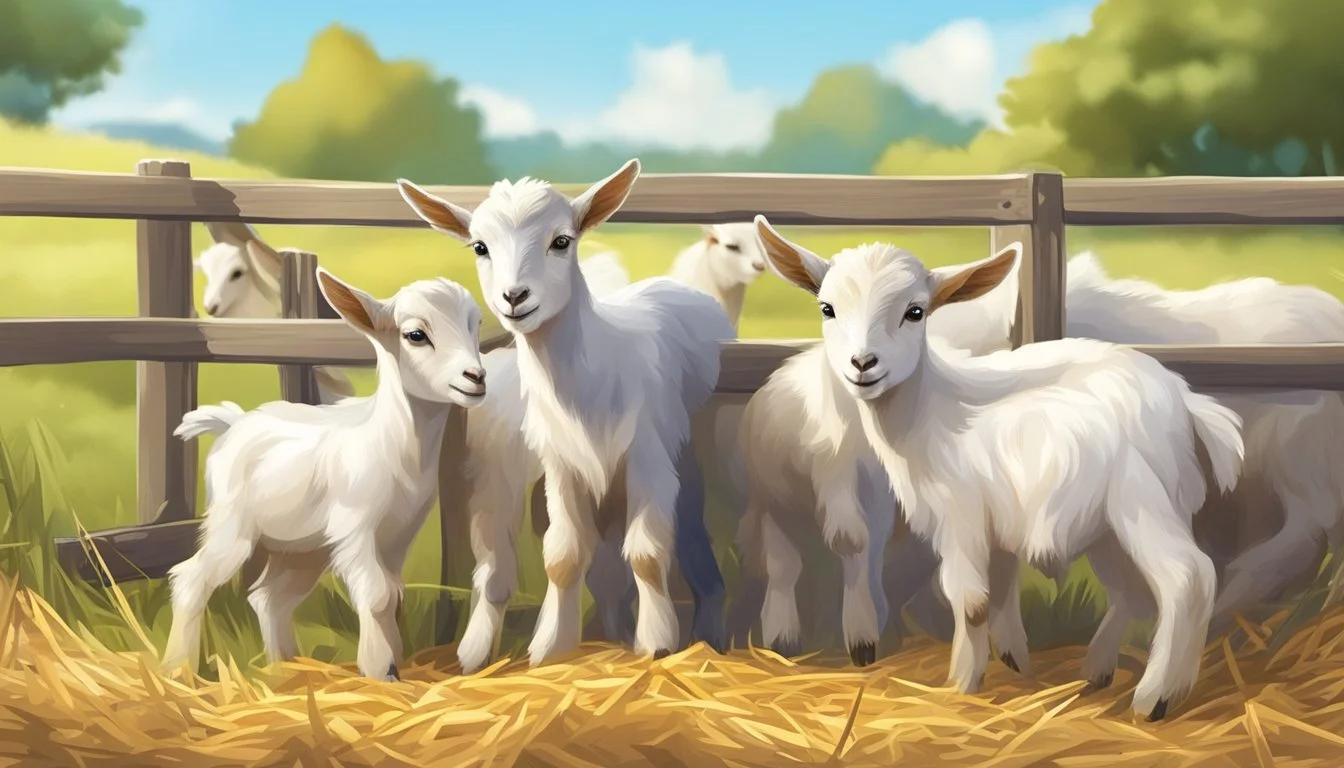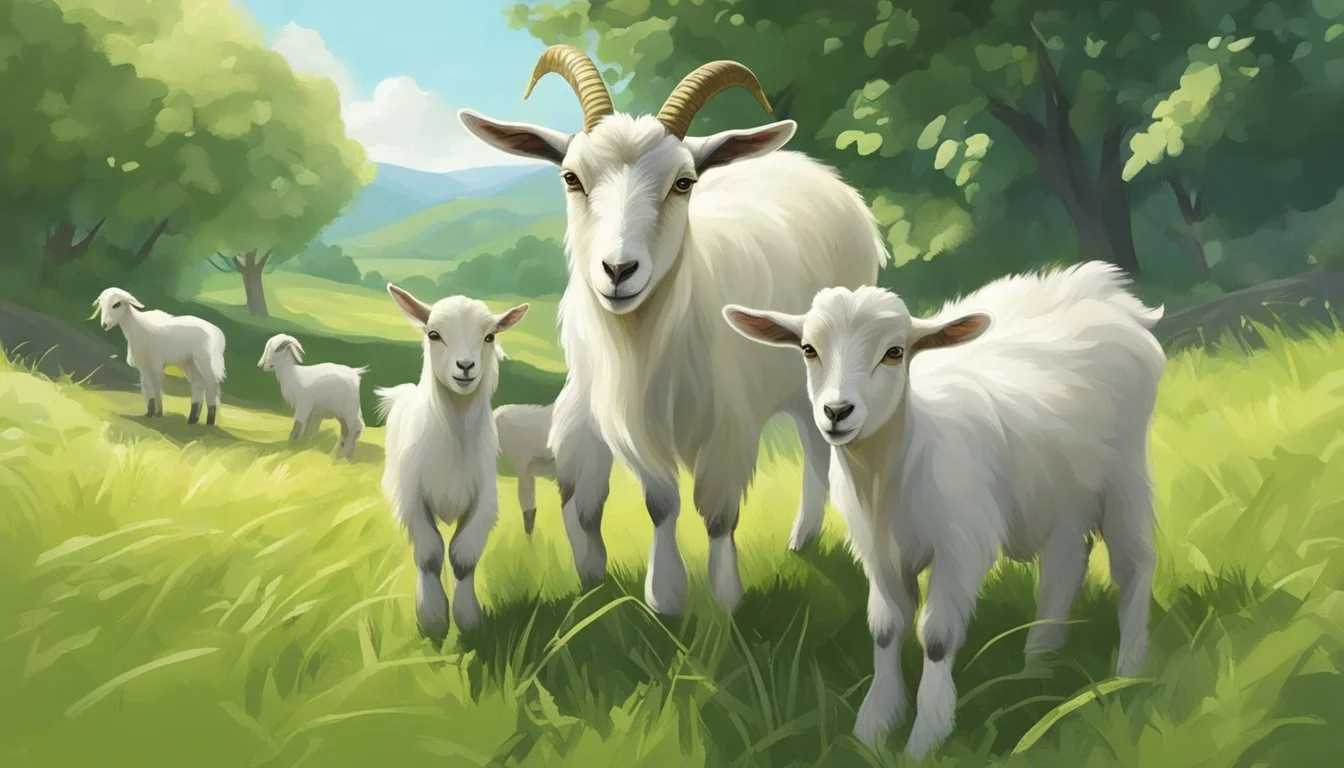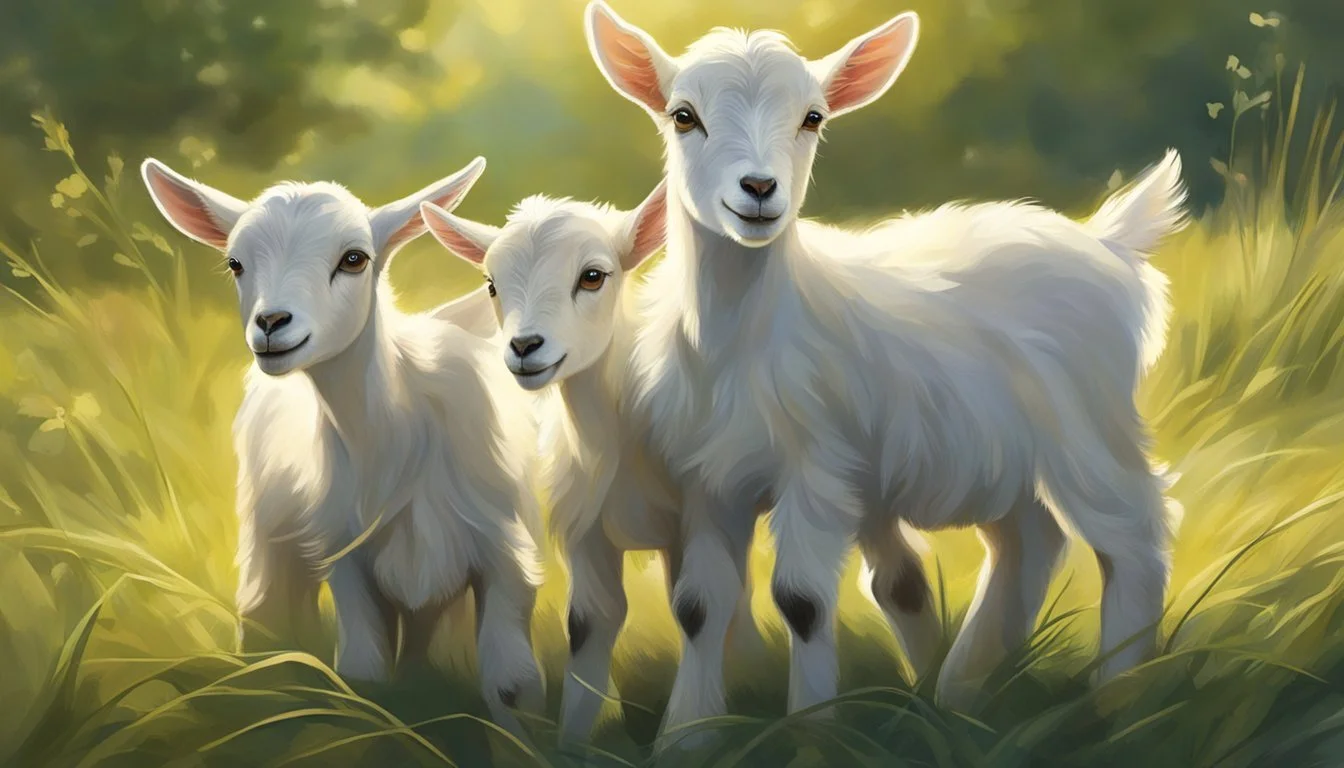When Should I Wean Baby Goats?
Key Considerations for Timely Weaning
Weaning baby goats is a crucial step in their development, marking the transition from a milk-based diet to solid foods. The appropriate time to wean often falls between two and three months of age. The key factor in determining when to wean is the kid's growth progress; they should ideally weigh 2.5 to 3 times their birth weight before the weaning process begins. Weaning too early or too late can have implications for the health and growth potential of the kid.
Weaning is more than just a dietary change; it's an important part of a goat's social and physical development. Baby goats, known as kids, begin to nibble on hay and grass within their first weeks of life, which helps to prepare their rumens for processing solid food. The transition should be gradual and monitored to ensure kids are adapting well and continuing to gain weight. Careful attention to this process helps establish a foundation for their overall well-being and future productivity.
As they grow, kids will begin eating more solid foods, and their dependency on milk will naturally decrease. It's essential for goat farmers to provide a stress-free environment during weaning, with adequate nutrition and comfort to support the kids through this significant change. A successful weaning process contributes to robust immune systems and social development, enabling the young goats to thrive in their new stage of life.
Understanding Goat Weaning Basics
When it comes to raising healthy goat kids, understanding the weaning process is essential. It involves guiding the young from a milk-based diet to solid foods and is pivotal for their development and independence.
Weaning Definition and Importance
Weaning is the gradual reduction of a goat kid's reliance on its mother's milk, transitioning to a diet of solid foods. This process is crucial as it supports the kid's immune system and prepares them for independence. Proper weaning contributes to their ability to thrive into adulthood and ensures they achieve necessary growth milestones.
The Role of the Mother Goat
The mother goat, or doe, naturally initiates weaning by increasingly rebuffing the kid's attempts to nurse. This encourages the kids to start grazing and become more self-sufficient. However, in some cases, human intervention may be required to support weaning, especially if the doe allows nursing for too long, affecting her health or the growth of the kid.
Weaning Age Considerations
Goat kids are commonly weaned between the ages of 2 and 3 months. The specific timing can depend on several factors such as the kid's developmental stage and health. It's important to ensure that the goat kid has reached an appropriate weight—often double their birth weight—before starting the weaning process.
Breed-Specific Weaning Insights
Different goat breeds may have varying weaning requirements. For instance, dairy breeds might be weaned earlier compared to meat breeds due to different growth rates and nutritional needs. It is essential to research the particular breed's tendencies when planning the weaning schedule to ensure optimal development of the goat kids.
Each subsection within this guide reflects the practices most conducive to raising well-adjusted and healthy goat kids. Each factor presented is interrelated and contributes to the overarching objective of successful weaning.
Preparing for Weaning
To ensure a smooth transition from milk to a solid food diet, preparing for weaning involves understanding the nutritional requirements, gradually introducing solid foods, creating a safe environment in a weaning pen, and managing the critical colostrum intake and early nutrition.
Nutritional Requirements
When weaning baby goats, their nutritional needs must be carefully managed. Initially, they have relied entirely on liquid milk which is rich in fat and protein. As they transition, their diet will need to include solid foods that meet their needs for maintenance and growth. This is particularly important during the weaning period when milk is no longer a dietary component.
Introduction to Solid Foods
The introduction of solid foods is a gradual process. Start by feeding baby goats high-quality roughage such as hay and progressively include a solid food diet of grains. This helps their rumen develop properly. A milk replacer can be used in tandem with solid foods to ensure the kids receive adequate nutrition during this transition period.
Creating a Weaning Pen
A dedicated weaning pen is crucial for the process. This area should be safe, stress-free, and allow the kids to acclimate without the presence of their mothers. According to tips for success from Farmhouse Guide, it's beneficial to familiarize the kids with this space while still with their mother before fully weaning.
Colostrum and Early Nutrition
The early stage of a goat's life is underpinned by colostrum intake, vital for immunity and early growth. After birth, this first milk is rich in essential nutrients and antibodies. Ensuring each kid receives colostrum will set a strong foundation for the weaning process that follows.
The Weaning Process
The weaning process is a critical transition period for baby goats, requiring careful consideration of methods, timing, and monitoring to ensure their health and well-being.
Gradual Weaning
Gradual weaning entails reducing the frequency of nursing over time. Baby goats should be offered high-quality solid feed to supplement reduced milk intake. Feeding times gradually increase for solid feed while milk is lessened, easing them onto a diet of roughages and concentrates. This approach helps minimize stress for both doe and kids, as it closely mimics the natural weaning process they would experience in the wild.
Cold Turkey Weaning
On the other hand, some farmers opt for cold turkey weaning, where baby goats are separated from their mothers abruptly. This method should only be employed if kids have reached the appropriate weaning age, typically between 8 to 10 weeks. They must have a strong dietary foundation with solid food before this abrupt shift. While it is a faster method, it can induce significant stress, so extra care must be taken to ensure the kids' environment is comfortable and they have plenty of feed.
Monitoring Weaning Progress
Monitoring weaning progress is vital. Farmers should track growth rates and observe for any signs of distress or illness. Adequate care for baby goats during weaning includes observing feeding behavior to ensure kids are consuming enough solid food and maintaining a clean and safe environment to reduce the risk of disease.
Handling Stress and Separation
The weaning process can induce stress, which can lead to health issues. To address this, constant access to fresh water and high-quality feed is essential. Environmental enrichments, such as providing areas for climbing and play, can also alleviate stress. Social support through keeping weaning kids together can help buffer separation stress, as they take comfort in the presence of their peers.
Health and Wellbeing During Weaning
When weaning goat kids, their health and wellbeing are paramount. It is critical to monitor common health concerns, ensure up-to-date vaccination and deworming protocols are followed, and actively manage parasites and diseases during this transition period.
Common Health Concerns
During weaning, kids can experience stress that may weaken their immune system, leading to health issues. One should look for changes in appetite, stool consistency, and signs of discomfort. These symptoms can indicate underlying issues that may require immediate attention.
Vaccination and Deworming
Vaccinations and deworming are essential preventative measures to protect weaning kids from common diseases and parasites. It is recommended to consult a vet to establish an appropriate schedule based on the specific needs of the herd. This includes timely administration of vaccines to boost the immune system and strategic deworming to prevent infestations.
Managing Parasites and Diseases
Due to developing immune systems, weaning kids are more susceptible to parasites and diseases such as coccidiosis. Strict hygiene, proper feeding, and clean water sources are key in disease prevention. Regular fecal testing and appropriate treatments, as advised by a vet, can help mitigate the risks of parasite-related diseases.
Environment and Living Conditions
Providing an ideal environment with the proper living conditions is crucial for the health and well-being of baby goats during weaning. They require a secure shelter, sufficient space, and a clean habitat to thrive post-weaning.
Appropriate Shelter and Bedding
Baby goats need a draft-free shelter that protects them from the elements. The shelter should have ample bedding, such as straw or wood shavings, to maintain warmth and absorb moisture. A heat lamp may be necessary in colder climates to ensure the kids remain at a comfortable temperature.
Fencing and Space Requirements
A sturdy fence is essential to keep baby goats safe from predators and to prevent escape. The enclosure should provide adequate space for the goats to move, play, and grow, following the guideline of at least 200 square feet per goat for outdoor areas.
Maintaining a Clean Habitat
Regularly removing manure and soiled bedding is vital to prevent the spread of disease and parasites. Baby goats require a clean environment; therefore, their living space should be sanitized frequently to maintain optimal health conditions.
Caring for Weaned Baby Goats
Once weaned, baby goats should be monitored closely to ensure they are adjusting well to their new diet and habitat. Their living space should continue to meet their needs, with easy access to fresh water and proper nutrition to support their development.
Feeding and Nutrition Post-Weaning
Post-weaning nutrition is crucial for the continued growth and health of young goats. Proper feeding strategies ensure they transition smoothly from milk to solid foods, supporting essential rumen development and overall well-being.
Transitioning to Pasture and Hay
After weaning, it's essential to introduce goats to pasture and hay. These should be the primary components of their diet to encourage rumen development. Goats must have access to a variety of high-quality forage to help them gradually adapt to a more fibrous diet, as this mimics their natural feeding behavior and provides necessary nutrients for growth.
Dry Feed and Water Access
In addition to pasture, offering a balanced dry feed ensures that the weaned goat kids get all the critical nutrients they need. The dry feed should be provided in a creep feeder, allowing them free access while preventing larger animals from consuming it. Continuous access to fresh, clean water is equally vital to help regulate their digestion and keep them hydrated.
Rumen Development and Solid Feed
Young goats’ rumen development is key to their ability to digest solid feed efficiently. Introducing a pelleted starter feed alongside hay encourages this growth, as the roughage stimulates cud chewing and rumen activity. An optimal diet promotes a healthy weight gain and overall health, laying the foundation for healthy adult goats.
Bottle Feeding After Weaning
Post-weaning bottle feeding may still be necessary for some kids, especially if they were weaned earlier than normal or require additional nutrition. Kids that need to continue bottle feeding should gradually receive less milk replacer over time to encourage more solid feed consumption and support natural weaning processes.
Additional Considerations
When weaning baby goats, several key factors must be considered beyond simply marking a date on the calendar. Timing, type of goat, and preparatory care are pivotal for a smooth transition from milk to solid foods.
Identifying the Right Weaning Age
The appropriate age to begin weaning goats can vary, typically falling between 60 and 90 days. However, the individual goat's health and development should guide this decision. A strong indicator of readiness for weaning is when a kid has reached a certain milestone in their growth, usually a doubling of their birth weight.
Weaning Meat vs. Dairy Goats
The weaning approach may differ between meat goats and dairy goats. Meat goats, which are raised primarily for their flesh, might be weaned earlier to optimize their growth rates for market. In contrast, dairy goats, valued for milk production, could benefit from a slightly longer weaning period to ensure they've developed adequately for maximum milk yield in the future. It's important to account for the nutritional needs that vary between meat goats and dairy goats.
Pre-weaning Preparation and Care
Prior to weaning, it's crucial to establish a solid nutritional foundation. Introduce a diet that includes high-quality roughage, such as hay or pasture, to support their maintenance and growth once milk is removed from their diet. Monitoring your kid's body condition is essential to ensure they are thriving and gaining weight at a healthy rate before beginning the weaning process. Early weaning should only be considered if the kid is healthy and has reached an adequate size and weight.
Frequently Asked Questions
When it comes to weaning goat kids, the timing and approach can significantly impact their growth and development. This section addresses some common inquiries that arise during the weaning process.
Ideal Weaning Scenarios
Goat kids are generally ready to be weaned when they have reached a weight that is adequate for their breed and age. This is typically when they have multiplied their birth weight, and it happens around 2 to 3 months of age. Weaning should not be solely calendar-based; weight gain is a crucial determinant, as it indicates appropriate development and readiness to transition from milk to solid feed.
Weaning Multiple Goat Kids
In cases where you are weaning multiple goat kids, consistency is crucial. They should all be at a similar stage of development to ease the weaning process collectively. If they are in a shared environment, it's important to ensure that all kids have ample access to quality solid feed to support their post-weaning growth.
Post-weaning Growth and Development
After weaning, the diet should support the kid's continued growth and development. Focus should be on providing a balanced diet that includes high-quality forage and a suitable ration of concentrate feeds that foster healthy rumen function and overall well-being. Monitoring their growth post-weaning is critical to ensure the transition is not negatively impacting their health or growth rate.
Conclusion
Deciding when to wean baby goats is a critical decision that impacts their health and development. Generally, the weaning process begins when baby goats—also referred to as kids—reach two to three times their birth weight, which typically occurs between 60 and 90 days of age. It's essential for baby goats to receive adequate nutrition post-weaning to support their continued growth and health.
Producers should ensure that a diet of high-quality roughage such as grass and hay is available to the kids after weaning. A gradual transition from the mother's milk to solid foods can help minimize the stress experienced by the kids. Observing the kids for signs of readiness, such as showing interest in solid foods or reaching the appropriate weight milestones, can inform the timing of weaning.
The weaning of baby goats holds significant importance and should be approached methodically. By weaning at the optimal time and providing the proper nutrition afterwards, the healthy development and welfare of goat kids can be effectively promoted. For further reading on weaning procedures and tips, refer to helpful resources such as When To Wean Goats, What To Expect & Tips for Success and The Homesteading Hippy's guide on weaning goats.
Appendix
This section provides essential terminology and guidance on when to seek professional advice during the weaning process of baby goats.
Glossary of Weaning Terms
Wean a goat: The process of transitioning a goat kid from mother's milk to solid food.
Milking: The act of extracting milk from a doe, often associated with the shift in milk production during weaning.
Bucklings: Male goat kids which may be weaned at a different pace depending on the goat herd management practices.
Nursing sessions: Periods when goat kids feed on their mother's milk before starting the weaning process.
Umbilical cord: A cord detached post-birth, often treated with iodine to prevent infection.
Disbudding: A common procedure performed early in a kid's life to prevent horn development, usually before the weaning process begins.
Lice: A parasitic concern in goats that can be more prevalent under stress, such as weaning.
Moldy grain: A dangerous feed contaminant to be avoided, especially during stressful periods like weaning.
When to Consult a Veterinarian
They should consult a veterinarian if they notice any signs of distress or illness in kids during weaning. The veterinarian can provide guidance on issues such as poor weight gain, which could signal that milking should continue, or if medical intervention is required. For Boer goats, owners sometimes seek veterinary advice for weaning due to their fast growth rates and high milk production needs. Also, if a kid has a persistent umbilical infection despite treatment with iodine, or if there are signs of lice infestation or ingestion of moldy grain, professional health assessments may be necessary.









